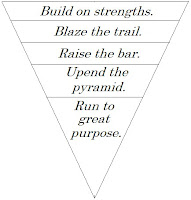In our work in economic development and complex project management, we often encounter failed projects and programs, that came to grief due to community opposition to the proposals, and which we are sometimes asked to resuscitate.
One of the causes of failure is the long standing engineering practice of first designing a project and then trying to “sell” it to the community.
This is why many new critically important infrastructure projects don’t get done, and the whole community ends up paying for it in increased costs and greater inefficiencies. The extra costs are often not immediately obvious until a factory closes because it is not competitive, an environmental mishap endangers lives, or an infrastructure failure disrupts commerce.
The conventional approach to designing and selling projects has been around forever, and you will find the “achieve stakeholder buy-in” in almost every request for proposal.
Instead, we use an approach called “strategic doing” which involves key stakeholders in the process of creating projects or sub-projects connected to the main project. The projects become part of a ecosystem of synergistic/self-supporting activities.
People agree to proceed with the cluster of projects — including the main project — because they have an interest or stake in the outcome. They also get to have a say in the design.
When we approach projects this way, the opposition to projects evaporates because the projects, are designed to benefit all stakeholders, are more meaningful and relevant. Rough edges are removed that would otherwise be a sources of irritation or dissatisfaction.
We adopted this “join in” approach on a recent strategic planning project for two counties — Steuben and Chemung –along the I-86 corridor in Western New York and their seven municipalities bookended by Corning and Elmira.
We worked with 70 or so local government, community and business leaders in two sets of highly intensive three day workshop sessions just three weeks apart, to design some 50 projects to achieve their goals of developing an “innovation corridor” and simultaneously creating a more vibrant community.
The region was successful, along with the Binghamton area (known collectively as the Southern Tier), in securing one of two $500 million investments by the State of New York, in competition with other regions across the State.
We also spent a considerable amount of time helping our client develop a governance strategy. How do you set up a multiplicity of projects for success, each with a multiplicity of different stakeholders interests?
For a start, you need a project manager at the core that can see the big picture and is determined to get things done, to work closely with each of the project teams, just as you do with complex major projects or systems of systems engineering projects. You also need the owners of each of the community sub-projects to have both a degree of autonomy for decision making but also responsibility to the greater whole. This demand clear set of rules of engagement about how each of the project teams will coordinate with others, including a requirement to report progress to the project manager, or to seek help when difficulties are encountered.. It’s a kind of community systems-of-systems economic and community development approach.
Naturally, we have used our knowledge of how to run complex major projects, to help our community clients successfully handle the big and the complex.
Here’s a link in the a case study in the Systems Engineering Book of Knowledge about some of our methods.
The kinds of questions we ask about governance issues include:
Resources: What human, physical, financial, knowledge, support, temperaments and other resources will you need to undertake this project, who owns or has control of them, and how could you acquire them?
Optimal outcome: What is the ideal outcome from this project? What does “success” look like?
Structure: What structure will you adopt for the project that will ensure that those responsible for carrying out the project report to all key stakeholders, rather than a select or influential few?
Ownership: Who is the ultimate owner of the project and how might you obtain their support and commitment?
Mobilizing: How can we tap into the passions of people so they not only support the project, but actively help to win support for its political acceptance and implementation?
Commitment: How will we foster a sense of ownership and or “join in” so people unite behind a decision?
Hearing and acting on concerns: How do we provide greater certainty for quietly harboring doubts? In situations where consensus is not possible, how do we ensure that all voices have been heard OR people feel heard? How will we act on concerns?
Attention to results: How can we balance the needs/outcomes for the individual, the community and the organization?
Sustainability: How will we ensure that the changes that occur as a result of implementing this project will be adopted and sustained, beyond our tenure or involvement in the process?
Accountability: How can we go about flagging unacceptable behavior and actions when it may have serious repercussions/downsides for the project or the community?
Governance Innovation: How will we know when the system we set up to govern the project is not working (is not meeting the needs of the stakeholders)? How should we plan to renegotiate the way the project is managed to ensure success?



